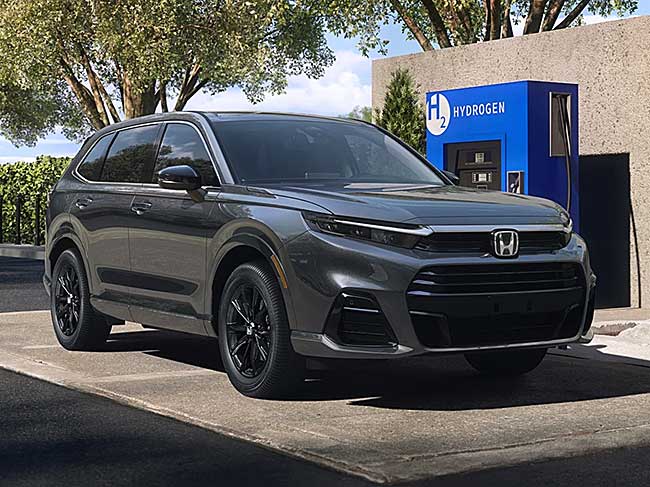
In an exciting development for the automotive industry, Honda and General Motors have unveiled their lease plans for the all-new 2025 Honda CR-V e:FCEV, a hydrogen fuel cell electric vehicle. This innovative vehicle will be available exclusively in California, starting July 9, 2024. The collaboration between these automotive giants marks a significant step towards sustainable transportation, combining cutting-edge technology with practical leasing options to make hydrogen fuel cell vehicles more accessible to consumers.
Key Features of the 2025 Honda CR-V e:FCEV
The 2025 Honda CR-V e:FCEV is a groundbreaking vehicle that combines the benefits of hydrogen fuel cells with the convenience of plug-in charging. Key features include:
- Zero Emissions: The CR-V e:FCEV is a zero-emissions vehicle, contributing to cleaner air and a healthier environment.
- Hydrogen Fuel Cell System: Developed in collaboration with General Motors, the fuel cell system provides a driving range of up to 270 miles1.
- Plug-In Charging Capability: The vehicle includes a 17.7-kWh battery pack, allowing for up to 29 miles of electric-only driving before the hydrogen fuel cell system kicks in1.
- Advanced Technology: The CR-V e:FCEV is equipped with a 10.2-inch digital instrumentation display, a 9-inch touchscreen, wireless Apple CarPlay and Android Auto compatibility, and a 12-speaker Bose premium audio system.
Lease Options and Incentives
Honda has announced three competitive lease options for the CR-V e:FCEV, designed to cater to different customer needs:
- 2-Year Lease: $489 per month with $2,989 due at signing, including $25,000 in hydrogen refueling credits.
- 3-Year Lease: $459 per month with $2,959 due at signing, including $15,000 in hydrogen refueling credits.
- 6-Year Lease: $389 per month with $2,889 due at signing, including $30,000 in hydrogen refueling credits.
These lease options also include up to 21 days of access to a rental vehicle from Avis while in California, 24/7 roadside assistance, and eligibility for California’s Clean Air Vehicle Stickers, allowing single-occupant HOV access.
Availability and Distribution
The CR-V e:FCEV will be available through a network of 12 approved Honda dealerships in select California markets, including six dealerships in Southern California, five in the San Francisco Bay Area, and one in the Sacramento area1. This strategic distribution ensures that customers in key regions have access to this innovative vehicle.
Benefits of Hydrogen Fuel Cell Vehicles
Hydrogen fuel cell vehicles, like the CR-V e:FCEV, offer several advantages over traditional internal combustion engine vehicles and even some electric vehicles:
- Quick Refueling: Hydrogen fuel cells can be refueled in just a few minutes, similar to gasoline vehicles, making them convenient for long-distance travel.
- Long Driving Range: The CR-V e:FCEV offers a driving range of up to 270 miles, reducing the need for frequent refueling stops.
- Environmental Benefits: Hydrogen fuel cells produce zero emissions, contributing to cleaner air and reduced greenhouse gas emissions.
- Energy Efficiency: Hydrogen fuel cells are highly efficient, converting hydrogen into electricity with minimal energy loss.
Challenges and Future Prospects
While hydrogen fuel cell vehicles offer numerous benefits, there are still challenges to overcome:
- Infrastructure Development: The availability of hydrogen refueling stations is currently limited, particularly outside of California. Expanding this infrastructure is crucial for the widespread adoption of hydrogen fuel cell vehicles.
- Production Costs: The production of hydrogen fuel cells and the vehicles themselves can be expensive. However, advancements in technology and increased production volumes are expected to reduce costs over time.
- Public Awareness: Educating consumers about the benefits and practicality of hydrogen fuel cell vehicles is essential for increasing adoption rates.
Honda and General Motors Collaboration
The partnership between Honda and General Motors is a testament to the potential of hydrogen fuel cell technology. By combining their expertise and resources, these automotive giants are paving the way for a more sustainable future. The CR-V e:FCEV is the first production plug-in hydrogen fuel cell electric vehicle made in America, showcasing the innovative capabilities of both companies.
Conclusion
The introduction of the 2025 Honda CR-V e:FCEV represents a significant milestone in the journey towards sustainable transportation. With its advanced hydrogen fuel cell system, plug-in charging capability, and competitive lease options, the CR-V e:FCEV offers a practical and environmentally friendly alternative to traditional vehicles. As Honda and General Motors continue to innovate and expand the availability of hydrogen fuel cell vehicles, the future of clean transportation looks promising.